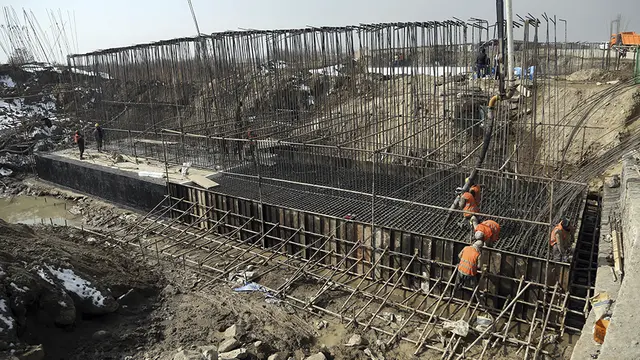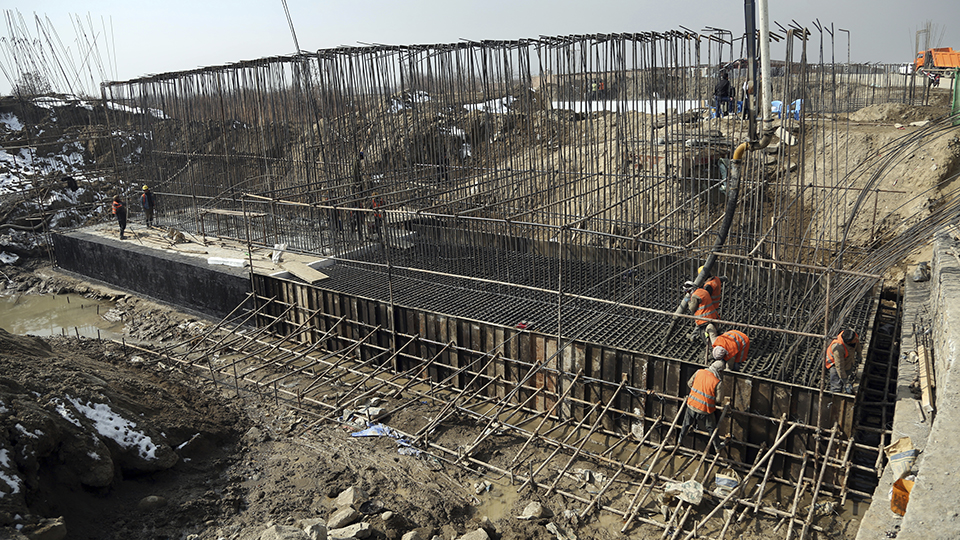
The Special Inspector General for Afghanistan Reconstruction (SIGAR), an independent U.S.watchdog created in 2008, has concluded that while two decades of rebuilding efforts in Afghanistan has "yielded some success," it has been "marked by too many failures." In a report released earlier this month, officials conducted more than 760 interviews and reviewed thousands of government documents.

Special Inspector General for Afghanistan Reconstruction (SIGAR) John F. Sopko
In its most recent lessons learned report,
"What We Need to Learn: Lessons from Twenty Years of Afghanistan Reconstruction,"
SIGAR states the U.S. government spent $145 billion in an attempt to "rebuild Afghanistan, its security forces, civilian government institutions, economy, and civil society", and another $837 billion on warfighting. Yet the watchdog says on the reconstruction part, billions of dollars were wasted by the U.S. government "as projects went unused or fell into disrepair. "
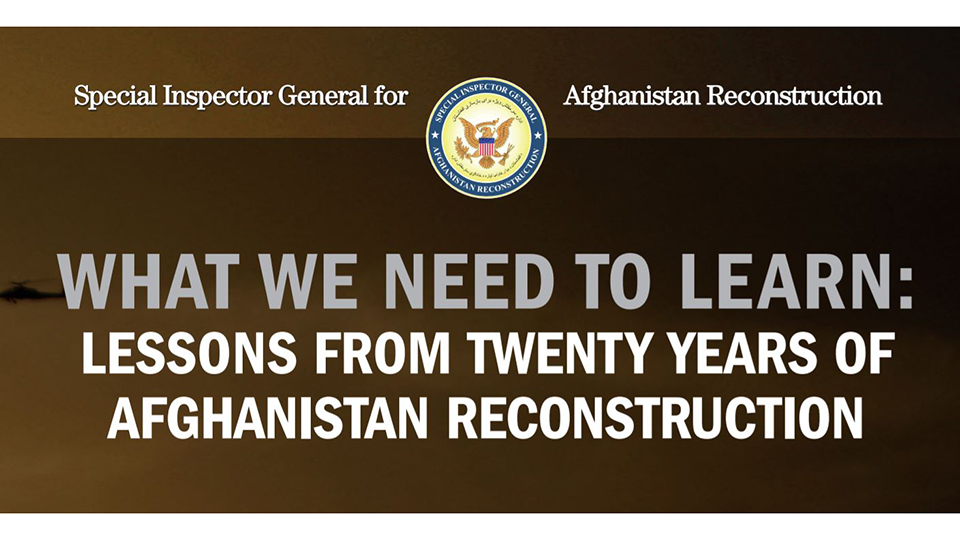
SIGAR has the authority to examine the entire $145 billion reconstruction effort. It has published more than 600 reports including 11 lessons learned reports since 2008. Here's how the reconstruction funds were wasted and misappropriated by the U.S. government, according to the SIGAR's oversight work.
'Ghost' soldiers
The 300,000-strong Afghan National Army (ANA) and Afghan National Police (ANP) collapsed swiftly in just a week as the Taliban advanced, which shocked the world. But the report by the independent watchdog has some clues.
In the special reports on ANA and ANP funding by SIGAR, it admitted that ANA's process for collecting unit-level attendance data had "limited oversight and weak controls," and "there are no requirements that supervisory ANA officials observe attendance data collected at lower level units." Likewise, in a 2015 audit report, SIGAR claimed that "more than $300 million in annual, U.S.-funded salary payments (to Afghan National Police) is based on partially verified or reconciled data." The actual number of ANP and ANA remains unclear.
In 2019, during a U.S. effort to crack down on so-called "ghost soldiers", nearly 42,000 soldiers and policemen disappeared from the payroll rosters in just two months. As commanders embezzled money by paying the salaries of "ghost soldiers," many of the ANA and ANP personnel were reportedly unpaid for months.
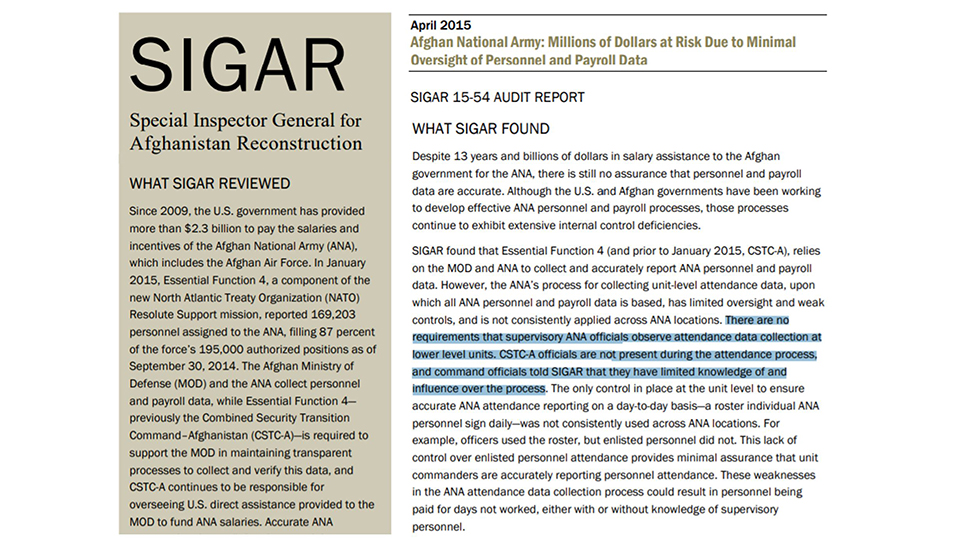
Source: SIGAR Special Report on Salary Data of Afghan National Army (04/2015)
Counternarcotics
Opium production flourished in Afghanistan during the Soviet occupation in 1980s. The CIA funded Mujahedeen and warlords started to grow the plant extensively for additional revenue, according to Alfred McCoy's book "The Politics of Heroin: CIA Complicity in the Global Drug Trade.”
The Taliban's nationwide ban on poppy growing was no longer in effect after the U.S. invasion of Afghanistan in 2001. To curtail the poppy cultivation and drug trade, the U.S. government spent more than $8.6 million between 2002 and 2017 in counter narcotics efforts in Afghanistan but didn't achieve much success.
Afghanistan remained the world's largest opium producer and the scale of poppy cultivation continued to grow, according to the United Nations Office on Drugs and Crime (UNODC).
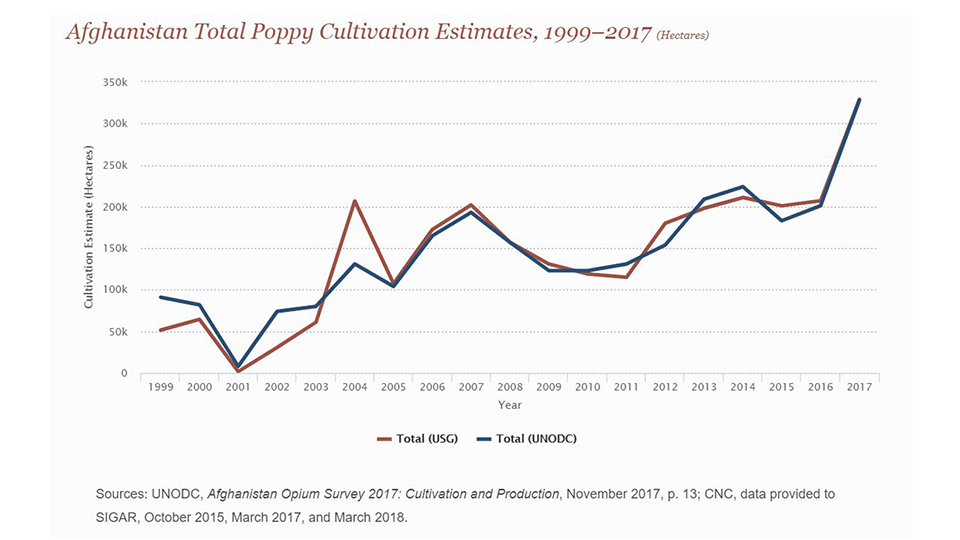
Source: 'Counternarcotics: Lessons from the U.S. Experience in Afghanistan' completed by SIGAR (06/2018)
Tofu, made in Afghanistan
One of the more bizarre reconstruction projects in Afghanistan was the Soybeans for Agricultural Renewal in Afghanistan Initiative (SARAI) implemented by the American Soybean Association (ASA) and overseen by the U.S. Department of Agriculture (USDA). The Fox News Channel reported that this $34-million program was involved in mismanagement, poor government oversight and financial waste based on the audit findings by the SIGAR.
In its inquiry letter to the USDA,the independent watchdog highlighted the issue of USDA's lack of feasibility assessment or value-chain studies before giving a greenlight to this program.
An evaluation of soybean cultivation in Afghanistan between 2005 and 2008 sponsored by UK government concluded that "soybeans were inappropriate for conditions and farming practices in northern Afghanistan, where the program was implemented," SIGAR emphasized.
In addition, to creating a local soybean economy, a nonprofit organization based in Iowa constructed and managed the Afghan Soybean Factory at a cost of at least $1.5 million in Afghanistan.But as farmers in northern Afghanistan abandoned their efforts in growing soybean after harvest failures, the factory has instead been forced to import at least 4,000 metric tons of soybeans from the U.S. at a cost of over $2 million to try to maintain its operation.
"The significant problems creating a market for soybean products in Afghanistan should have been expected since Afghans apparently have never grown or eaten soybeans before," according to a press advisory from SIGAR after its review report on this case was released.
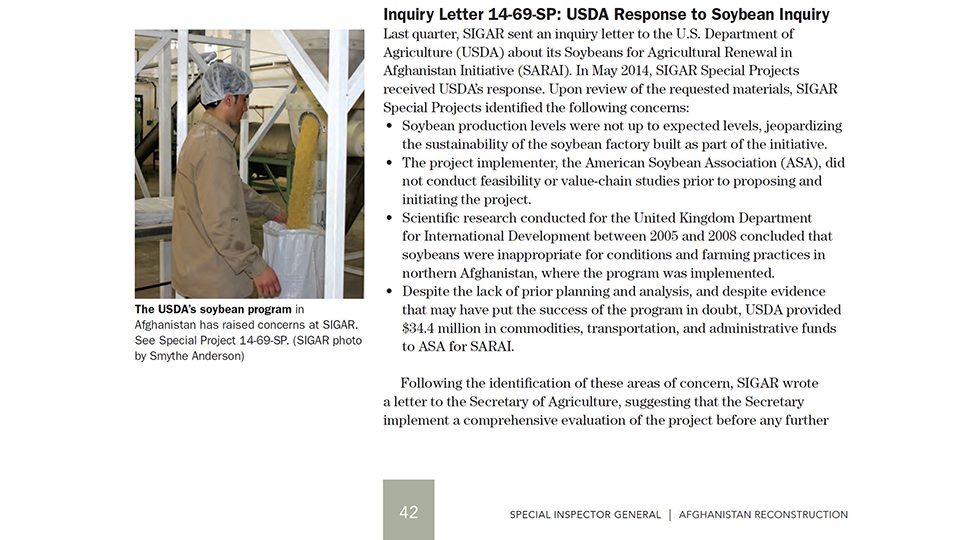
Source: SIGAR Quarterly Report to the U.S. Congress (07/2014), Section “Special Projects”
The most expensive gas station in the world
"DOD charged the American taxpayer $43 million for what is likely the world's most expensive gas station," Special Inspector General John Sopko said when he reviewed the construction of a compressed natural gas (CNG) filling station in Sheberghan, Afghanistan.
SIGAR found that in other countries, for example in neighboring Pakistan, the total cost for constructing a CNG filling station could be about $500,000 at most.And DOD has failed to provide documentation to explain the high cost of the construction, the SIGAR report said.
According to the U.S. Department of Defense (DOD), the Task Force for Business and Stability Operations (TFBSO) was in charge of this project. As a division of the DOD, TFBSO was established in 2006 to stabilize the post-invasion Iraqi and Afghan economy.
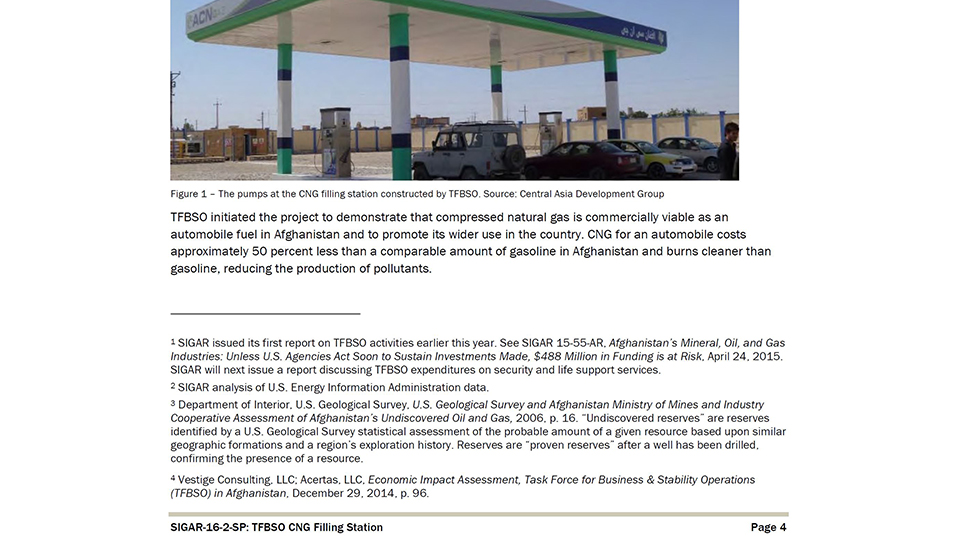
Source: 'DOD's Compressed Natural Gas Filling Station in Afghanistan: An Ill-conceived $43 Million Project' completed under SIGAR's Office of Special Projects (10/2015)
In a separate investigation, SIGAR found that TFBSO had spent $150 million in funding private housing and private security guards for some of its employees in Afghanistan.
"SIGAR's preliminary review indicates that TFBSO leadership rented specially furnished, privately owned 'villas' and hired contractors to provide 24-hour building security, food services, and bodyguards for TFBSO staff and visitors traveling in country," SIGAR wrote in an inquiry letter to former Secretary of Defense Ash Carter.
SIGAR alleged that government employees could have lived on U.S. military bases, saving taxpayers "tens of millions of dollars."
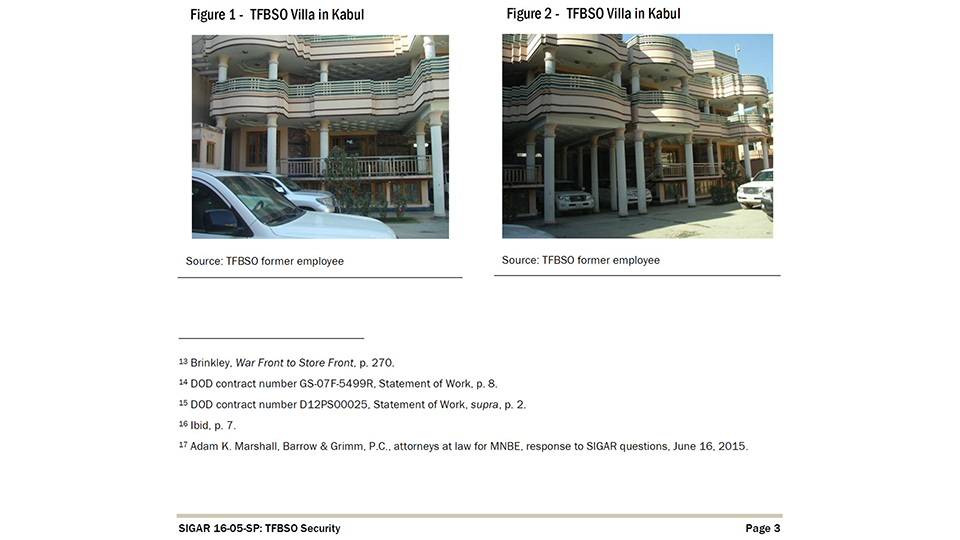
Source: SIGAR inquiry letter about TFBSO's rented villas in Afghanistan (11/2015)
Weapons lost
DOD officials have reportedly failed to effectively track the weapons, and experts are concerned that many of them may have been fallen in the hands of criminals and militants.
In 2014, SIGAR discovered that some 747,000 weapons and auxiliary equipment worth approximately $626 million provided by the U.S. military to Afghan National Security Forces between 2004 and 2014 have been lost. SIGAR also found out that as of November 2013, there were more than 112,000 weapons provided to the ANA and ANP, far exceeding their needs and requirements, including 83,184 AK-47 assault rifles.
Schools with structural and operational deficiencies
For years, United States Agency for International Development (USAID) and U.S. State Department claimed that they had invested $769 million in building or refurbishing over 680 schools for the Afghans between 2008 and 2013. Yet, the agency told Buzzfeed in 2015 that the actual number should be around 563, a large drop from what it had long claimed.
After conducting site visits at 171 Afghan schools funded by USAID, SIGAR reported in 2019 that "many of the schools had structural deficiencies (e.g., showed signs of settlement or deterioration, cracks or large holes in their roofs, and damaged or removed windows and doors) that could potentially impact safety and the delivery of education."
SIGAR also found that in USAID's Afghan Children Read project, books provided by the agency were in poor condition, with blank/loose pages, misspelling and low-quality paper.
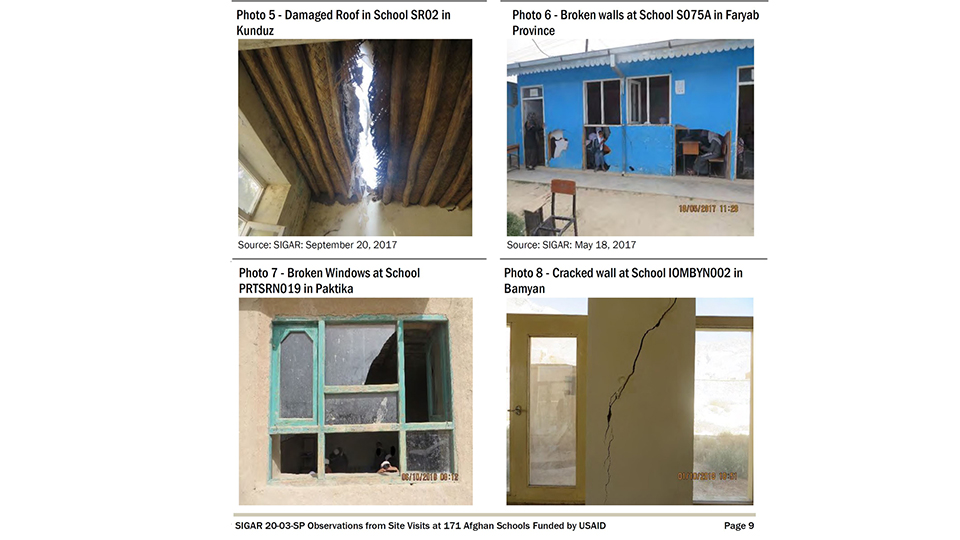
Source: 'Observations from Site Visits at 171 Afghan Schools Funded by USAID' completed under SIGAR's Office of Special Projects (10/2019)
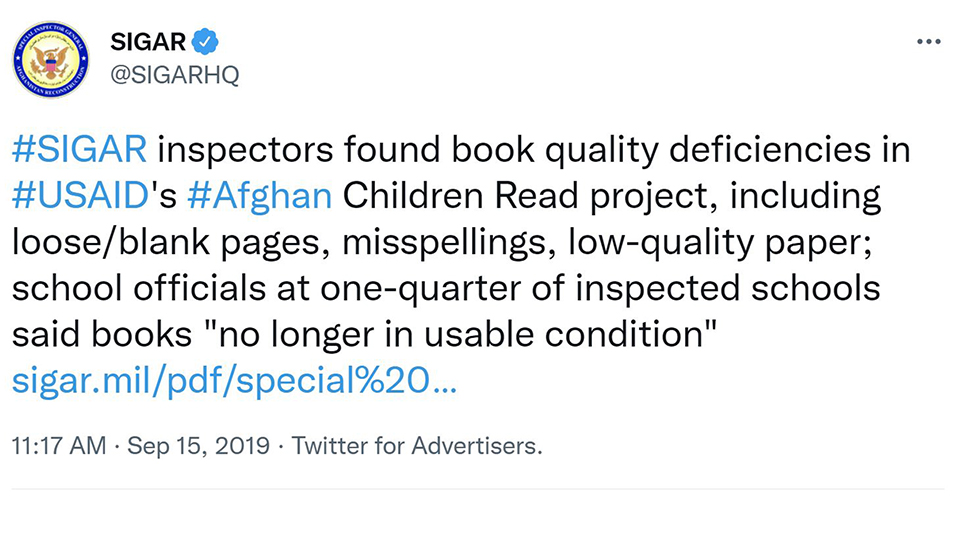
Lessons Learned
SIGAR revealed that U.S. reconstruction money spent in Afghanistan has been lost to fraud, waste and abuse over the past 20 years and the U.S. troubled reconstruction efforts failed to bring peace and sustainable benefits to the Afghan people.
"If the goal was to rebuild and leave behind a country that can sustain itself and post little threat to U.S. national security interests, the overall picture is bleak. By most measurements, security has progressively worsened," SIGAR reported.
Among the seven "key lessons" learned from America's 20-year involvement in Afghanistan,SIGAR highlighted the importance of tailoring reconstruction strategy and efforts to the Afghan context.
It said that effective rebuilding efforts are required to have a deep understanding of the Afghanistan's social, economic, and political dynamics. Without this background knowledge, U.S. officials "forced Western technocratic models onto Afghan economic institutions" and "empowered powerbrokers who preyed on the population or diverted U.S. assistance away from its intended recipients to enrich and empower themselves and their allies".
Check out
The China Report
, our new weekly newsletter.Subscribe here!
 简体中文
简体中文

